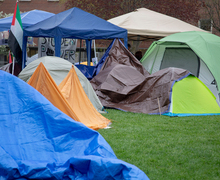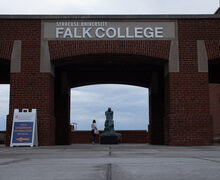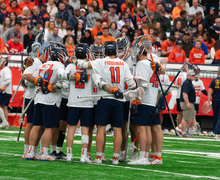Barillari: Addition of vice presidential candidates to election improves SA
CORRECTION: In a previous version of this column, the date when the referendum was passed was misstated. The change was passed by SA in April of this year. The Daily Orange regrets this error.
It’s official: The Student Association election season is now a team sport.
This year, when students head to MySlice beginning Nov. 11 to vote for SA’s next president, they won’t be selecting just an individual candidate.
For the first time, students will choose a predetermined president and vice president pairing. For the first time, the selection of SA’s leadership will be a non-fragmented decision.
As of Wednesday, three teams announced their candidacy on the Syracuse University campus. Ivan Rosales and Simone Goldslager, Duane Ford and Nia Boles and Boris Gresely and Daniela Lopez, each a presidential candidate and corresponding vice president, respectively, have enthusiastically jumped into the race for the representative body’s top spots.
But the addition of the vice president position to the race may be more important than constituents realize for both themselves and the organization.
Before the passage of the change last April, which allows vice presidents to campaign, only the president and home college representatives were on the ballot to be elected by the student body. The president then appointed a vice president in a similar fashion to the appointment of cabinet positions.
This style was problematic, however, because it potentially allowed a non-elected vice president to become the leader of a democratically run organization if the president stepped down. Despite SA’s recent debates concerning whether the organization is truly a governing body, such inconsistencies to a democratic approach could leave students without the possibility of holding its leader accountable.
The new system justly strips the association of this potential issue and ensures the students’ top “defender” is undoubtedly their chosen representative.
The inclusion of vice presidential candidates will hopefully also work to eliminate the lack of definition between the roles of the vice president and the chief of staff. In recent years, and especially during the last several election cycles, members and candidates have highlighted the issue and attempted to better differentiate the responsibilities of each role.
Though some progress has been made by assigning a more internal focus to the chief of staff and external emphasis to the vice president, adding the latter to the ballot should allow further distinguishability. The vice president should now be responsible for working on campaign platform promises and allow the chief of staff to be the distinct manager of organization members.
Goldslager, Rosales’ vice presidential running mate, has already made clear she has projects of her own, which are simultaneously part of the duo’s shared platform. This independence is a worthy campaign tactic, as it adds a level of legitimacy to the new inclusion of the vice presidency campaign.
She said she plans to tackle campus diversity concerns — one of Rosales and Goldslager’s three pillars, which also include student engagement and academic excellence.
Similarities can be seen between the Rosales/Goldslager vision for SA and the one Ford and Boles hope to enact.
The team is also promoting a platform with concentrations on diversity and academics, but is taking the bold initiative of adding tuition into their mix.
Gresely and Lopez sponsor the most unconventional platform, with aims to significantly alter SA’s operations into a three-branch system. Gresely hopes to bring the organization an internal finance board and create more representative accountability. Meanwhile, Lopez plans to better student-faculty relations.
Within the upcoming weeks, presidential debates will allow the constituency to better differentiate between the contrasting three platforms. With the inclusion of vice presidential candidacy, a specific debate should be arranged for the three candidates to present their ideas as well.
Three teams now have one month to compete for the same goal: the SU student vote.
Let the race begin.
Rachael Barillari is a senior political science and Middle Eastern studies major. Her column appears weekly. She can be reached at [email protected] and followed on Twitter at @R_Barillari.
Published on October 10, 2013 at 12:43 am




